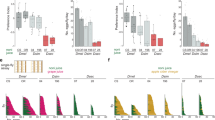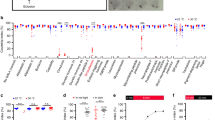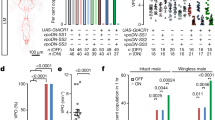Abstract
Many animals attract mating partners through the release of volatile sex pheromones, which can convey information on the species, gender and receptivity of the sender to induce innate courtship and mating behaviours by the receiver1. Male Drosophila melanogaster fruitflies display stereotyped reproductive behaviours towards females, and these behaviours are controlled by the neural circuitry expressing male-specific isoforms of the transcription factor Fruitless (FRUM)2,3,4,5. However, the volatile pheromone ligands, receptors and olfactory sensory neurons (OSNs) that promote male courtship have not been identified in this important model organism. Here we describe a novel courtship function of Ionotropic receptor 84a (IR84a), which is a member of the chemosensory ionotropic glutamate receptor family6, in a previously uncharacterized population of FRUM-positive OSNs. IR84a-expressing neurons are activated not by fly-derived chemicals but by the aromatic odours phenylacetic acid and phenylacetaldehyde, which are widely found in fruit and other plant tissues7 that serve as food sources and oviposition sites for drosophilid flies8. Mutation of Ir84a abolishes both odour-evoked and spontaneous electrophysiological activity in these neurons and markedly reduces male courtship behaviour. Conversely, male courtship is increased—in an IR84a-dependent manner—in the presence of phenylacetic acid but not in the presence of another fruit odour that does not activate IR84a. Interneurons downstream of IR84a-expressing OSNs innervate a pheromone-processing centre in the brain. Whereas IR84a orthologues and phenylacetic-acid-responsive neurons are present in diverse drosophilid species, IR84a is absent from insects that rely on long-range sex pheromones. Our results suggest a model in which IR84a couples food presence to the activation of the fruM courtship circuitry in fruitflies. These findings reveal an unusual but effective evolutionary solution to coordinate feeding and oviposition site selection with reproductive behaviours through a specific sensory pathway.
This is a preview of subscription content, access via your institution
Access options
Subscribe to this journal
Receive 51 print issues and online access
$199.00 per year
only $3.90 per issue
Buy this article
- Purchase on Springer Link
- Instant access to full article PDF
Prices may be subject to local taxes which are calculated during checkout




Similar content being viewed by others
References
Wyatt, T. D. Pheromones and Animal Behaviour: Communication by Smell and Taste (Oxford Univ. Press, 2003)
Dickson, B. J. Wired for sex: the neurobiology of Drosophila mating decisions. Science 322, 904–909 (2008)
Demir, E. & Dickson, B. J. fruitless splicing specifies male courtship behavior in Drosophila . Cell 121, 785–794 (2005)
Manoli, D. S. et al. Male-specific fruitless specifies the neural substrates of Drosophila courtship behaviour. Nature 436, 395–400 (2005)
Stockinger, P., Kvitsiani, D., Rotkopf, S., Tirian, L. & Dickson, B. J. Neural circuitry that governs Drosophila male courtship behavior. Cell 121, 795–807 (2005)
Benton, R., Vannice, K. S., Gomez-Diaz, C. & Vosshall, L. B. Variant ionotropic glutamate receptors as chemosensory receptors in Drosophila . Cell 136, 149–162 (2009)
Wightman, F. & Lighty, D. L. Identification of phenylacetic acid as a natural auxin in the shoots of higher plants. Physiol. Plant. 55, 17–24 (1982)
Markow, T. A. & O’Grady, P. Reproductive ecology of Drosophila . Funct. Ecol. 22, 747–759 (2008)
Silbering, A. F. et al. Complementary function and integrated wiring of the evolutionarily distinct Drosophila olfactory subsystems. J. Neurosci. 10.1523/JNEUROSCI.2360-11.2011 (21 September 2011)
Abuin, L. et al. Functional architecture of olfactory ionotropic glutamate receptors. Neuron 69, 44–60 (2011)
van der Goes van Naters, W. & Carlson, J. R. Receptors and neurons for fly odors in Drosophila . Curr. Biol. 17, 606–612 (2007)
Ferveur, J. F. Cuticular hydrocarbons: their evolution and roles in Drosophila pheromonal communication. Behav. Genet. 35, 279–295 (2005)
Yao, C. A., Ignell, R. & Carlson, J. R. Chemosensory coding by neurons in the coeloconic sensilla of the Drosophila antenna. J. Neurosci. 25, 8359–8367 (2005)
Barata, A. et al. Analytical and sensorial characterization of the aroma of wines produced with sour rotten grapes using GC-O and GC-MS: identification of key aroma compounds. J. Agric. Food Chem. 59, 2543–2553 (2011)
Kim, J., Jeon, C. O. & Park, W. A green fluorescent protein-based whole-cell bioreporter for the detection of phenylacetic acid. J. Microbiol. Biotechnol. 17, 1727–1732 (2007)
Bray, S. & Amrein, H. A putative Drosophila pheromone receptor expressed in male-specific taste neurons is required for efficient courtship. Neuron 39, 1019–1029 (2003)
Kohatsu, S., Koganezawa, M. & Yamamoto, D. Female contact activates male-specific interneurons that trigger stereotypic courtship behavior in Drosophila . Neuron 69, 498–508 (2011)
Kurtovic, A., Widmer, A. & Dickson, B. J. A single class of olfactory neurons mediates behavioural responses to a Drosophila sex pheromone. Nature 446, 542–546 (2007)
Root, C. M. et al. A presynaptic gain control mechanism fine-tunes olfactory behavior. Neuron 59, 311–321 (2008)
Wang, L. et al. Hierarchical chemosensory regulation of male–male social interactions in Drosophila . Nature Neurosci. 14, 757–762 (2011)
Vosshall, L. B. & Stocker, R. F. Molecular architecture of smell and taste in Drosophila . Annu. Rev. Neurosci. 30, 505–533 (2007)
Jefferis, G. S. et al. Comprehensive maps of Drosophila higher olfactory centers: spatially segregated fruit and pheromone representation. Cell 128, 1187–1203 (2007)
Cachero, S., Ostrovsky, A. D., Yu, J. Y., Dickson, B. J. & Jefferis, G. S. Sexual dimorphism in the fly brain. Curr. Biol. 20, 1589–1601 (2010)
Yu, J. Y., Kanai, M. I., Demir, E., Jefferis, G. S. & Dickson, B. J. Cellular organization of the neural circuit that drives Drosophila courtship behavior. Curr. Biol. 20, 1602–1614 (2010)
Croset, V. et al. Ancient protostome origin of chemosensory ionotropic glutamate receptors and the evolution of insect taste and olfaction. PLoS Genet. 6, e1001064 (2010)
Ewing, A. W. & Manning, A. The effect of exogenous scent on the mating of Drosophila melanogaster . Anim. Behav. 11, 596–598 (1963)
Shorey, H. H. & Bartell, R. J. Role of a volatile female sex pheromone in stimulating male courtship behaviour in Drosophila melanogaster . Anim. Behav. 18, 159–164 (1970)
Spieth, H. T. Courtship behavior in Drosophila . Annu. Rev. Entomol. 19, 385–405 (1974)
Lee, T. & Luo, L. Mosaic analysis with a repressible cell marker for studies of gene function in neuronal morphogenesis. Neuron 22, 451–461 (1999)
Lai, S. L. & Lee, T. Genetic mosaic with dual binary transcriptional systems in Drosophila . Nature Neurosci. 9, 703–709 (2006)
Han, D. D., Stein, D. & Stevens, L. M. Investigating the function of follicular subpopulations during Drosophila oogenesis through hormone-dependent enhancer-targeted cell ablation. Development 127, 573–583 (2000)
Rong, Y. S. et al. Targeted mutagenesis by homologous recombination in D. melanogaster . Genes Dev. 16, 1568–1581 (2002)
Bischof, J., Maeda, R. K., Hediger, M., Karch, F. & Basler, K. An optimized transgenesis system for Drosophila using germ-line-specific φC31 integrases. Proc. Natl Acad. Sci. USA 104, 3312–3317 (2007)
Benton, R., Sachse, S., Michnick, S. W. & Vosshall, L. B. Atypical membrane topology and heteromeric function of Drosophila odorant receptors in vivo . PLoS Biol. 4, e20 (2006)
Alcorta, E. & Rubio, J. Intrapopulational variation of olfactory responses in Drosophila melanogaster . Behav. Genet. 19, 285–299 (1989)
Wong, A. M., Wang, J. W. & Axel, R. Spatial representation of the glomerular map in the Drosophila protocerebrum. Cell 109, 229–241 (2002)
Yu, H. H. et al. A complete developmental sequence of a Drosophila neuronal lineage as revealed by twin-spot MARCM. PLoS Biol. 8, e1000461 (2010)
Chiang, A. S. et al. Three-dimensional reconstruction of brain-wide wiring networks in Drosophila at single-cell resolution. Curr. Biol. 21, 1–11 (2011)
Rueckert, D. et al. Nonrigid registration using free-form deformations: application to breast MR images. IEEE Trans. Med. Imaging 18, 712–721 (1999)
Evers, J. F., Schmitt, S., Sibila, M. & Duch, C. Progress in functional neuroanatomy: precise automatic geometric reconstruction of neuronal morphology from confocal image stacks. J. Neurophysiol. 93, 2331–2342 (2005)
Barber, C. B., Dobkin, D. P. & Huhdanpaa, H. The Quickhull algorithm for convex hulls. ACM Trans. Math. Softw. 22, 469–483 (1996)
Guindon, S. & Gascuel, O. A simple, fast, and accurate algorithm to estimate large phylogenies by maximum likelihood. Syst. Biol. 52, 696–704 (2003)
Edgar, R. C. MUSCLE: multiple sequence alignment with high accuracy and high throughput. Nucleic Acids Res. 32, 1792–1797 (2004)
Letunic, I. & Bork, P. Interactive Tree Of Life (iTOL): an online tool for phylogenetic tree display and annotation. Bioinformatics 23, 127–128 (2007)
Acknowledgements
We are grateful to B. Dickson, A. Hofbauer, T. Lee, the Bloomington Drosophila Stock Center, the Drosophila Species Stock Center and the Developmental Studies Hybridoma Bank for provision of plasmid vectors, Drosophila strains and antibodies. We are also grateful to A. Wong, J. Wang, R. Axel, H.-H. Yu and T. Lee for sharing raw image data. We thank D. Featherstone, J.-F. Ferveur, T. Kawecki, L. Keller, S. Martin and members of the Benton laboratory for comments on the manuscript. Y.G., J.-P.F. and J.C. are supported by the Centre National de la Recherche Scientifique (CNRS), the Agence Nationale de la Recherche (ANR; JCJC, GGCB-2010) and the Conseil Régional de Bourgogne (FABER). R.R. was supported by a Roche Research Foundation fellowship. G.S.X.E.J. is supported by the Medical Research Council and a European Research Council Starting Investigator Grant. Research in R.B.’s laboratory is supported by the University of Lausanne, a European Research Council Starting Independent Researcher Grant and the Swiss National Science Foundation.
Author information
Authors and Affiliations
Contributions
Y.G. and R.B. conceived the project. Y.G. performed the gene-targeting screen, contributed to the histological analysis and performed most of the behavioural experiments. R.R. performed the electrophysiological odour response screen, the fly odour stimulation assays and the phylogenetic analyses. J.-P.F. performed the chemical analysis. L.A. assisted in the generation and characterization of transgenic flies and contributed to the histological analysis. J.C. contributed to the behavioural experiments. G.S.X.E.J. performed the analysis of projection neurons. R.B. generated the DNA constructs, performed all other electrophysiological analyses and wrote the paper with contributions from Y.G., R.R., J.-P.F. and G.S.X.E.J.
Corresponding author
Ethics declarations
Competing interests
The authors declare no competing financial interests.
Supplementary information
Supplementary Information
This file contains Supplementary Tables 1-2 and Supplementary Figures 1-5 with legends. (PDF 3100 kb)
Rights and permissions
About this article
Cite this article
Grosjean, Y., Rytz, R., Farine, JP. et al. An olfactory receptor for food-derived odours promotes male courtship in Drosophila. Nature 478, 236–240 (2011). https://doi.org/10.1038/nature10428
Received:
Accepted:
Published:
Issue Date:
DOI: https://doi.org/10.1038/nature10428
This article is cited by
-
Identification of candidate genes associated with host-seeking behavior in the parasitoid wasp Diachasmimorpha longicaudata
BMC Genomics (2024)
-
Neural manifolds for odor-driven innate and acquired appetitive preferences
Nature Communications (2023)
-
Aggregation pheromones have a non-linear effect on oviposition behavior in Drosophila melanogaster
Nature Communications (2023)
-
The power of Drosophila genetics in studying insect toxicology and chemical ecology
Crop Health (2023)
-
Direct and correlated responses to artificial selection on foraging in Drosophila
Behavioral Ecology and Sociobiology (2023)
Comments
By submitting a comment you agree to abide by our Terms and Community Guidelines. If you find something abusive or that does not comply with our terms or guidelines please flag it as inappropriate.



